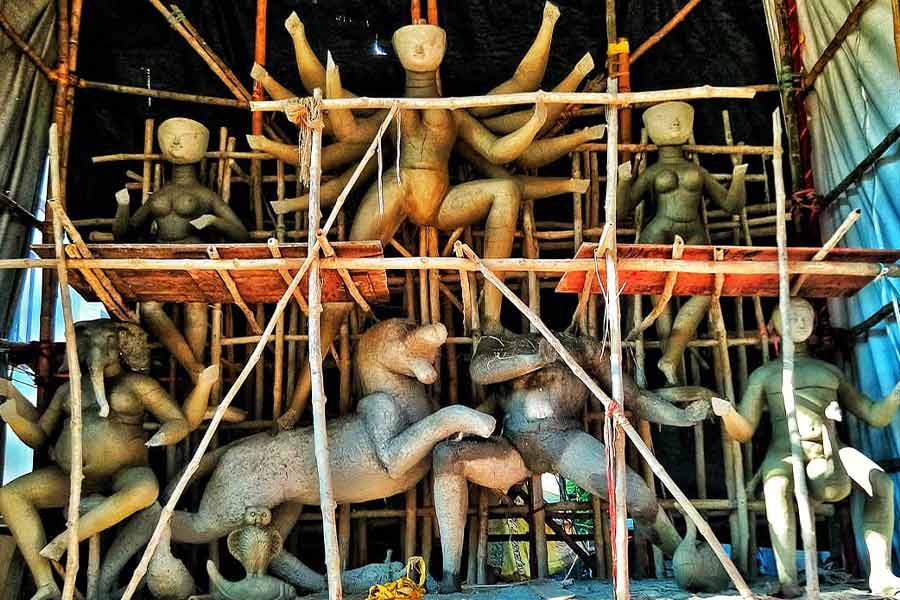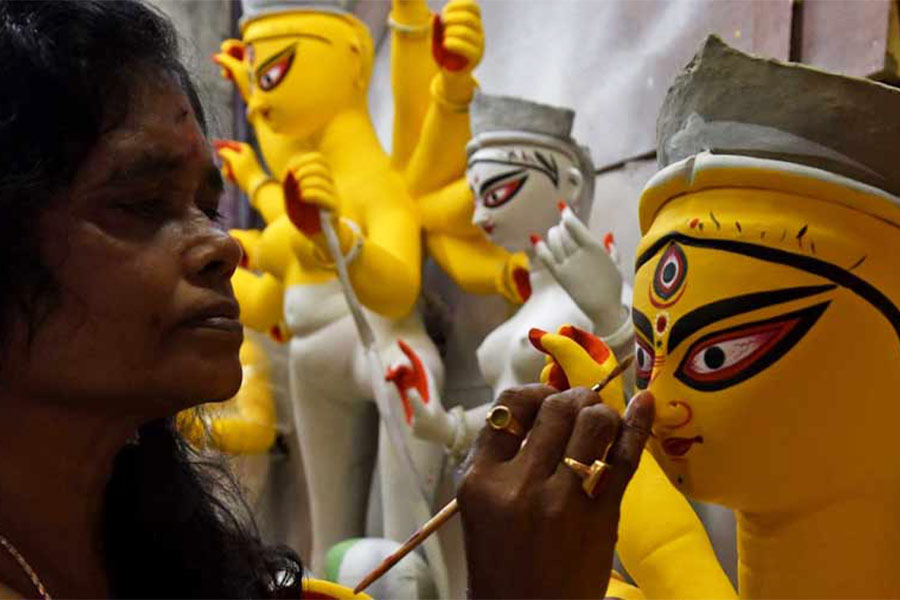Ashwiner sharodo prate, beje uthechhe aloko manjir…
It’s Mahalaya morning and the voice of Birendra Krishna Bhadra rings out as Mahishasurmardini plays on the FM app on my phone that I downloaded only for today — listening to the YouTube version feels like an abomination. I could hear the radio on at the neighbour’s as well as they listen to the same, just like the times when my mother and grandmother were around.
I grew up in a Christian household in Kolkata. Our family is a harmonious mix of Roman Catholic and Protestant. My father conducted the rosary nights, my brother and I had special Bible sessions with my grandmother, and we visited Bandel at least twice a year as my mother took the initiative responsibly before our exams and our new school sessions. But Durga Puja has been a socially and culturally relevant occasion for us, going beyond the religious aspect of it. For years, I have been asked how I speak Bangla and how I know ‘so much’ about Bengali culture — perhaps the tradition of listening to Mahishasurmardini played a part in it.
My first Durga Puja
My parents lived in a Christian locality in Thakurpukur when I was born. For the first few years of my life, I witnessed pompous Christmas celebrations that I now remember vaguely. Back then, I did not quite understand the concept of Durga Puja or any other festival apart from the ones we celebrated at home and in the neighbourhood. All other festivals were just holidays. During Durga Puja, the holiday was longer and the family visited my paternal grandparents. So the grandeur of the festival in Kolkata did not strike me until we moved to Behala when I was about seven or eight years old.
We were invited to our neighbours’ homes for pujas and received prasads on Saraswati Puja, Lakshmi Puja and other occasions. My first memory of Durga Puja is from around this time.

The Durga pratima of the puja committee near my house from a few years back Jaismita Alexander
My maternal grandmother whom I called Dudi — Didu spelt backwards — lived with us and she took me to the para pandal. I remember her dressing me up in a frock that I only wore for a party, much to my surprise. After all, we were not going far from home! “It's Durga Puja, every kid wears new clothes,” she said and I wondered why.
On reaching the pandal, I was astonished to see the grand idol adorned with shining jewellery and a red sari, under the massive chandelier. Her children stood at either side of her, and there were animals! She had a majestic lion and was fighting a “bad man” — I had seen this Hindu goddess before, but only in pictures or newspaper ads. The smell of the dhuno and the music of the dhak made the experience overwhelming for me.
Our domestic help who was accompanying us, pointed towards the idol and told me, “Ma Durga ke haath jod kore pronam koro (join your hands and pay your respects to Ma Durga).” Awestruck by the grandeur in front of me, I did whatever she told me. I remember having a series of questions in my mind as I walked home, still overwhelmed. I asked Dudi that if Durga had four kids already, why did other people call her ‘Ma’? Whose mother is she? She responded, “Everyone who believes her to be.” I think that’s when Durga Puja made a special place in my heart.
The first Mahalaya

Visiting Kumartuli also became a ritual during my college day. A glimpse from Kumartuli in 2018 Jaismita Alexander
I don’t know exactly when the ritual of listening to Mahishasurmardini began in our house, but it was definitely after we moved to Behala. I remember seeing Ma and Dudi prepare for the dawn the night before. It began with checking the working condition of the radio and getting dinner ready by 8.30pm so we could be in bed at least by 9.30pm. The radio frequency was set to All India Radio before sleeping and alarms were set for 3.50am — the extra 10 minutes for settling in and making coffee. In our household of tea lovers, coffee was on Mahalaya morning to keep the listeners awake.
My younger brother and I were not part of the plans when we were really little. My father would join the women until daybreak or until his eyes betrayed him and sleep took over. However, he was very enthusiastic about it all, and later even bought a three-piece music system that could play CDs and cassettes and also had a built-in radio! In those days, the radio was only turned on once a year at home and that was on Mahalaya morning.
The first time I joined Ma and Dudi, I must have been around nine years old. Like every year, they woke up at 3.50am and tuned into the radio. My mother hurried into the kitchen to make the coffee while my grandmother woke me up saying, “Mahalaya shunbi na? Oth! (Don’t you want to listen to Mahalaya? Wake up.)”
I was keen on joining them that year for two reasons — first, I felt left out in school when my friends spoke about waking up early to listen to Mahishasurmardini and the second, I was really looking forward to having coffee, which we kids weren’t allowed to have otherwise.

Birendra Krishna Bhadra recites 'Mahisasuramardini' TT Archives
Soon, my mother came out of the kitchen with three cups of coffee — two dark beverages for her and Dudi and one cup of milk with a sprinkling of coffee for me. I was immediately cranky and started complaining. As mother-daughter argued, the radio crackled and the music of a conch shell broke up our bickering as Dudi turned to us and said, “Shh! It’s starting.”
Ya Chandi began playing and I tried to figure out the lyrics. Soon after the music, a man’s voice was heard and sounded like he was chanting. Some words I understood, some I didn’t. As his pitch rose, I saw the dark sky turning light outside and felt a cool breeze enter from the open window. I remember that the experience gave me goosebumps.
For the next 90 minutes, I kept hurling questions at my mother and grandmother — Who was this man? Where were they singing? How does Ma Durga come to earth? I am sure, at that moment, they regretted encouraging me to join them and cursed the coffee. I must have fallen asleep during the last few minutes, and when I woke up, the morning felt anew. It felt festive. The Durga Puja fervour had touched me.

A night of pandal-hopping became a ritual for our family during Durga Puja Jaismita Alexander
Since then I have never missed a single year. As I grew up, Durga Puja became an event for our family to enjoy together. Perhaps not as grand as the Christmas celebrations, but my brother and I got new clothes, we went out for dinners, and went around the city on nightlong pandal-hopping tours.
When theme pujas started trending, my father replaced our Kodak camera with a digital camera because film rolls weren’t enough to capture all the creativity! That’s how invested my church-going, Lent-observing family was.
Keeping the traditions going
Looking back, I am glad my family imbibed the varied culture of the city even while keeping our faith. Otherwise, we would have missed knowing these emotions around Durga Puja. Now, when I speak to people from outside the state, or of other nationalities, I am able to tell them about the festival with a lot of emotion and personal feeling.
All these years, I have enjoyed Durga Puja with the same spirit as my peers, even having a few traditions of my own like visiting Kumartuli before Pujo. I have offered anjali, taken part in a barir pujo, shopped for new clothes, walked for miles and stood in queues for hours to visit a pandal. And all the excitement of Durga Puja still begins with Mahalaya for me. I believe, if you live in Kolkata, Durga Puja is a grand carnival that includes you in the celebration no matter what your faith or religion is.

Ekchala idol of a barir pujo at a friend’s house where we spent a day helping and participating in rituals Jaismita Alexander
Now, I am in my late 20s and my Ma and Dudi aren’t around anymore, but I maintain the ritual of listening to Mahishasurmardini. My father and brother find it difficult to wake up and stay awake but I have never missed a single year. Even today, I successfully made it through the 90 minutes without feeling drowsy — maybe because of the cup of coffee which is now black. As I watched the sky turn brighter, I felt a nip in the air. Jago, Maa Tumi Jago played on the FM and finally it felt like, Pujo chole elo (Pujo is almost here).


